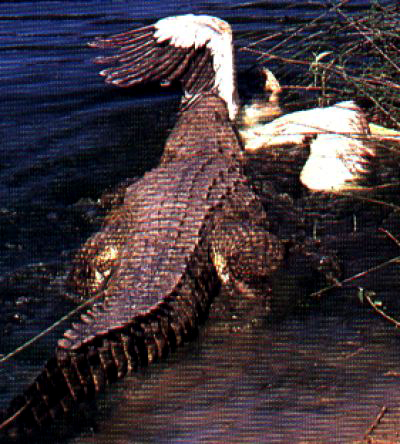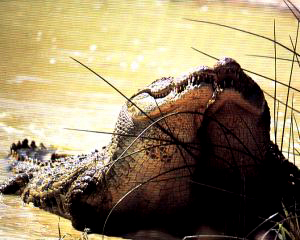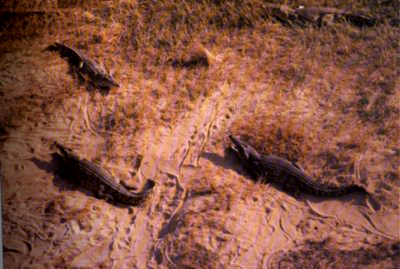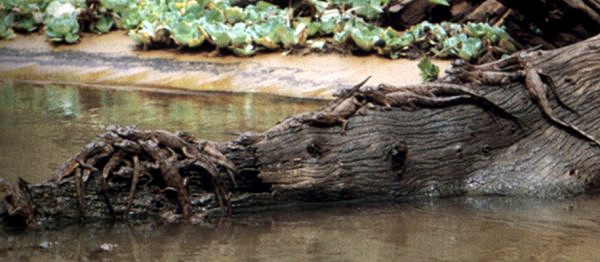
Crocodylus niloticus

For example, the Nile crocodiles that live on the Grumeti river in Tanzania, attain one of the largest sizes of all Nile crocodiles. Their feeding behaviour is also different. Since they receive most of their food once a year, through a huge wildebeest migration which comes through the river, these crocs are very infrequent eaters. They will take some small prey, but won't eat much until the annual migration.
Juveniles tend to be a dark olive or dark brown coloration with black bands running along the body down to the tail.
Adults tend to be one uniform color, generally a dark brown or gray. The abdomen in both is light yellow or white in both juveniles and adults.
Subspecies
Due to it's considerable range and variation, Crocodylus niloticus has also been divided into a number of different subspecies based on snout morphology and distribution.
| Crocodylus niloticus subspecies | Common Names |
|---|---|
| C.n.suchus | Central African Nile Crocodile |
| C.n.corviei | South African Nile Crocodile |
| C.n.africanus | The East African Nile Crocodile |
| C.n.chamses | West African Nile Crocodile |
| C.n.niloticus | Ethiopian Nile Crocodile |
| C.n.pauciscutatus | Kenyan Nile Crocodile |
| C.n.madagascariensis | The Malagasy Nile Crocodile or Croco Mada |
Coastal populations (including the island bound Madagascar C.niloticus) indicate a rather high salt tolerance with at least some pelagic traveling. One croc was sighted 7 miles off the Zululand coast, and many crocs have been seen on the Islands of Zanzibar and in the river mouths of Kenya.
Diet
Hatchlings prey on insects, small crustaceans and any other small creatures that they can get their jaws on.
Adults continue their piscivory but as size increases so do choices and Nile crocs are very cosmopolitan animals when it comes to prey. Zebra, wildebeest, antelope, warthogs, cattle & humans all are taken by large C.niloticus
Hunting
Due to their wide distribution and plentiful numbers, researchers have been able to conduct many studies and observations on these crocs. From these observations we are able to break down Nile croc hunting styles into two categories.
 A solitary Nile will patrol a river bank or lake and wait for possible prey items to come by. During this time they may chase and eat little fish or tackle large Nile perch to satisfy their hunger.
This may continue all day, with the croc patroling in the water and basking in the sun. Basically just lazing about (a common habit for top predators).
A solitary Nile will patrol a river bank or lake and wait for possible prey items to come by. During this time they may chase and eat little fish or tackle large Nile perch to satisfy their hunger.
This may continue all day, with the croc patroling in the water and basking in the sun. Basically just lazing about (a common habit for top predators).
When night falls, things change. Foraging increases at night with Niles being known to corral small fish onto the shore by using their bodies as living dams and forcing the fish to either move into the shallows or risk escape through the ever so sensitive jaws.
At night if a large animal comes to drink, the croc will submerge itself and get in as close a position to the animal as possible. As soon as it has reached it's position, the croc braces it's legs and tail in the mud and launches itself onto the animal, snapping at any available bodypart. Once grabbed, the animal is dragged (and in the cases of really strong Niles, bodyslammed) into the water where the croc will either drown it or remove a important bodily organ (say a neck for instance). Eating is rather simple and to the point, though if the animal is of uncomfortable size for swallowing and won't stay still in order for it to be ripped apart, crocs have been known to brace the animal on roots or logs in order to achieve their goal, thus showing a reptilian form of tool use.Niles will also hunt on land at night. This is rarely observed and mostly small animals and/or carrion are taken, but it does happen.

Pack hunting has been seen in Lake St. Lucia in South Africa. There, the crocs gather for the annual migration of shoalfish out of and into the lake from the Indian Ocean. This is for either spawning or feeding purposes and includes many different species of shoalfish. One in particular, the striped mullet (Mugil cephalus) the migration is a fairly constant event, one which attracts many crocodiles.
The crocodiles congregate in an area of the channel known as The Narrows, an area that is only 550 meters wide. There the crocs position themselves in a semi-lunar or straight line formation. By forming in this way, the crocodiles become living dams for the fish to pass by. Each croc maintains it's position and snaps up the fish as they try to get through. The crocs will stay until they are all full before breaking the dam.

Observations on Nile crocs have shown that some crocs are so daring that they will take their chances with even adult elephants. A croc will come up to a drinking elephant and snap it's jaws on the animal's trunk. The snap generates so much force that it breaks the elephant's trunk, which in the long run tends to kill the elephant (since a broken trunk means that they cannot eat or drink). Elephants don't like having their trunks snapped off and so will grab the daring crocodile and either stamp it to death and hang it's mangled body in a tree, or fling the animal far away.
One individual was observed being kicked from one end of a watering hole all the way to the other side. The stunned crocodile got up and ran off, thus proving that some crocodiles will try just about anything.
Yet even with such dangerous dispositions, Nile crocodiles and Hippos are known to frequent the same bodies of water and live together in harmony.
In many cases it seems to be a mutual tolerance, where one side of a lake or river belongs to the hippos and the other side belongs to the crocodiles, but there are cases in which their lifestyle extends a tad beyond tolerant.Observations of hippos and crocs have shown that a hippo will sometimes wade into a group of Nile crocs and investigate the animal that they are tearing up and eating. Even further, there are occasions where the hippo will join in the feast. This last part is strange since hippos are usually considered strict herbivores. It does make sense when one sees the parts that the animal goes for. Generally hippos will tear open the stomach and intestines in the hopes of finding the creature's last meal. Since most prey items of crocodiles are herbivorous, the hippo has a good chance of finding some somewhat processed food to eat. This happens during bad droughts.
Hippos and crocs have been seen cooperating in the scaring off of intruders into their territory. Again this happens in times when there is no room for sharing.Mother hippos have been seen placing their babies on beaches to rest next to large Niles while the mother goes off to sleep. The crocs tolerate the child (who may put spittle all over their tails) and offer (by their presence) a means of protection from lions and hyenas.
The same thing is true for crocodiles. Juvenile Niles have been seen climbing up and riding on the backs of wallowing hippos. This could both be for sunbathing and/or a free ride (maybe they do it to relive bygone days when they would ride on their mother and father's heads.)
The interspecial relationship between Nile crocodiles and hippos is truly an interesting one.
Reproduction
Courtship generally happens in special nesting areas, away from the usual spots. There, males will set up and vigorously defend their territories. This is accomplished by the showing of their backs, the raising of their heads high above the water followed by a loud head & jaw slap on the way down. Possible hissing and growling (Niles tend to be rather quiet in that area). If the intruder persists, the large male may then raise his head and torso out of the water, swell his neck, open his jaws and suddenly give chase through the shallows. The intruder will either be forced to make a speedy break onto land or face the male in a head to head bout which can become very messy. Lost pieces of tails, limbs and jaws have been documented in individuals who didn't clear out in time. Death is rare, but those who don't submit and leave can run the risk of such a fate.



Laying of the eggs takes between 20-30 minutes, during which time the females fall into a strange trance in which they are no longer aware of the outside world. This is a unique behaviour that seems to be typical of all egg laying reptiles and researchers can actually come up and pet the female (or in the case of Poachers, take the eggs) without her even caring. Clutch size is age dependent. Young females will lay between 16-20 eggs while older females can lay a whopping 80 eggs.
After egg laying, the nests are covered up and guarded for the next three months. Females tend to fast throughout this time, though group nesters may occasionally take turns going down for a nibble. Females will also remain over their nests during heavy rains to prevent possible drowning. Throughout this time females will attack any and all intruders into their nesting grounds. They will chase the intruder away, hissing and growling throughout the run.Despite their valiant efforts, croc eggs still get taken by the dozens. One particular animal that is fond of croc eggs is the Nile monitor lizard (Varanus niloticus) which has been observed hunting in pairs with one individual distracting the female while the other goes in and removes the eggs.

Upon hearing her baby's cries, the female comes ashore and starts to dig them out. This can take many hours, as the female must dig through tightly packed dirt and occasionally plants that have grown on or near the nest site.
After successfully opening the nest, the eggs suddenly explode to life, with hatchlings coming out at a continuous pace. The babies will continue their ultrasonic chirps to their mom, along with rapid tail wagging to help grab her attention. The mother will then grab the babies into her mouth where they will rest in a pouch that descends from her lower jaw to accomodate them. Unhatched eggs will be taken, shaken to see if they are alive, then either gently cracked open to help the hatching baby, or discarded if found to be infertile. The mother's pouch can contain up to 20 babies, but for older females with large litters, this means return trips. If a male is present, then he too will help bring the babies down to their nursery pool, which increases the transfer rate of the young to safety.The hatchlings will reside in a quiet nursery pool overhung by reeds where the female will watch over them for several weeks to several months. The babies will spend their time on "mommy's" head and back, or on top of each other on logs. They will also hunt around in the reeds for insects to fullfill their food requirements (babies must eat 5% of their weight in food a day). At the slightest sign of danger, the mother will rapidly vibrate her trunk muscles and the babies will dive into the water and submerge until the mother has given the all clear sign. Both male and female crocodiles have been observed leaping out of the water at low flying predatory birds in order to scare them away from the babies.

Socially raised babies will later join the group to help take down larger animals, or perhaps to ride on the back of hippos and watch the adults do their thing.
Dangers to Man
As one of the three titan crocs, Niles are definite man eaters, and many individuals are known to attack and kill unwary humans. For that reason (and the aggressive temperment that seems to permeate the creaturnalities of all African animals) people should watch themselves around large bodies of water in Africa.
Nile crocodiles make for interesting animals to observe, study and appreciate in their natural environments. They are indeed just as much an interesting part of the African fauna as lions and Elephants. They also give us a glimpse into what life might have been like millions of years ago.